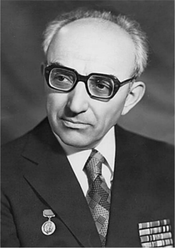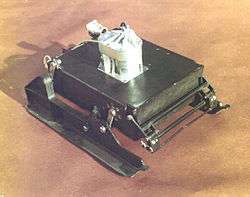Alexander Kemurdzhian
Aleksandr Leonovich Kemurdzhian[1][lower-alpha 1] (Russian: Александр Леонович Кемурджиан; Armenian: Ալեքսանդր Քեմուրջյան;[3] October 4, 1921 – February 25, 2003) was a Soviet Armenian mechanical engineer who worked at the VNIITransmash institute for the most of the second half of the 20th century. He is best known for designing Lunokhod 1, the first ever lunar rover.[4]
Alexander Kemurdzhian | |
|---|---|
 | |
| Born | October 4, 1921 |
| Died | February 25, 2003 (aged 81) Saint Petersburg, Russia |
| Nationality | Armenian |
| Citizenship | Soviet Union |
| Alma mater | Moscow Bauman Higher Technical College |
| Known for | designing Lunokhod 1, the first lunar rover |
| Scientific career | |
| Fields | Mechanical engineering |
| Institutions | VNII-100 (VNIITransmash) |
Early life
Kemurdzhian was born to Armenian parents[2][5] on October 4, 1921 in Vladikavkaz, today the capital of North Ossetia.[6][7][3] His father (b. 1898) and mother (b. 1901) were volunteers in the Russian Civil War with the 11th Red Army who happened to be in Vladikavkaz at the time of his birth.[7] His Turkish-Armenian paternal grandparents were from Trebizond who settled in Batumi in the late 19th century. His mother was from Rostov-on-Don.[8] His family settled in Baku, Soviet Azerbaijan when he was 5. He grew up there and considered Baku his hometown. His unskilled parents lived in poor conditions. In 1939 he began working as a Russian announcer at the Azerbaijani radio.[7]
In 1940 he enrolled at the Bauman Higher Technical College in Moscow.[6][7][3] With the start of the Eastern Front of World War II in 1941, he and other students of the tank department were assigned to repair damaged tanks until the institute was evacuated to Izhevsk.[7] In early 1942 he volunteered to join the Soviet Army.[7] He participated in the battles of Kursk, the Dnieper, and the Vistula–Oder Offensive.[3][6] He served in the 162nd Infantry Division of the NKVD.[7] He rose to the rank of senior lieutenant[7] by the time he was demobilized in 1946.[3] For his services, he was awarded the Order of Courage, Order of the Red Star (1944),[7] Order of the Patriotic War (1945, 1995),[7] Order of the Badge of Honour,[9] and the Medal "For Battle Merit".[7] Due to the disruption caused by the war, Kemurdzhian graduated from the department of tracked vehicles[9] of the Bauman Higher Technical College in 1951, some 11 years after enrolling.[7][3]
Career
In 1951 Kemurdzhian began working at the Leningrad-based All-Union Scientific-Research Institute No. 100 (VNII-100, now known as VNIITransmash),[3][7][9] whose "primary expertise was building tanks for the Soviet Army."[10] Kemurdzhian's research focused on continuously variable transmission in tracked vehicles.[7][3] In 1957 he defended his kandidat nauk thesis.[6][7][3][9] From 1959 on Kemurdzhian led research on air-cushion vehicles (hovercraft).[6][7][3]
Kemurdzhian authored 200 scientific publications (mostly papers, some six monographs)[3] and patented 50 inventions.[11][7]
Work on lunar rovers
Between 1963 and 1973[7] Kemurdzhian headed the team assigned to develop the chassis for the Lunokhod programme.[3][9] His team designed both Lunokhod 1 (1970) and Lunokhod 2 (1973).[9][3] In 1969 he was named deputy director and chief designer at VNIITransmash.[3] Under his leadership, the institute became a leader of space transport engineering.[3][7] In 1971 he became Doctor of Technical Sciences[9][7] after defending his dissertation based on his work on Lunokhod 1.[3] He was named professor in 1977.[7]
Kemurdzhian was personally interested in spaceflight and "remote-controlled space probes,"[10] which was known to Sergei Korolev.[12] In September 1963 Korolev met with VNIITransmash engineers to discuss the possibilities of developing lunar rovers.[13] The design sketches for the first lunar rover were completed by September 1965.[12] Kemurdzhian provided the main report on the possibility of creating the lunar rover.[14] Georgy Babakin, director of OKB Lavochkin, and Kemurdzhian worked closely to design the Ye-8 in 1966.[12] In 1967 a final lunar rover design was reached and a prototype was constructed.[12] Early models were sent to the moon on Luna 11, Luna 12 (1966) and Luna 14 (1968). Lunokhod 1, the finalized version, was designed by Kemurdzhian[12][4] and Babakin.[15] Kemurdzhian is credited with being the chief designer of the self-propelled chassis of Lunokhod-1.[14]
Lunokhod 1 was carried to the moon by Luna 17, which was launched on November 10 and landed on the moon on November 17, 1970.[16][17][18] It was the "first successful rover to operate beyond Earth"[16] and the "first self-propelled, crewless vehicle to operate on the moon."[19] It weighted 756 kg (1,667 lb) and was 4.42 m (14.5 ft) long and 1.92 m (6 ft 4 in) high. It carried cameras, transmitters and scientific instruments.[12] The remote-controlled robot traveled some 10.54 km (6.55 mi) in 10 months and sent back some 20,000 photos and 200 panoramas. It also completed over 500 lunar soil tests.[20]
Work on Mars lander vehicle

The M71 landers—Mars 2 and Mars 3—which were launched in 1971, both carried a small walking robot called PrOP-M (ПрОП-М, Pribor otsenti prokhodimosti - Mars, "instrument for evaluating cross-country movement") developed by Kemurdzian at VNIITransmash.[21]
Later years and death
In response to the Chernobyl disaster, Kemurdzhian led a team of researchers to develop, in May 1986, the robot STR-1 (СТР-1) to support the Chernobyl liquidators to investigate and cleanup the area.[11][9][3] In Chernobyl he was exposed to excessive radiation and was treated in a Moscow hospital for radiation burns.[11]
Kemurdzhian retired in 1998.[22][11] In 2000 he became a founding member of the St. Petersburg Branch of the Russian Academy of Cosmonautics (StPB RAC).[22] In November 2000 he was the chief speaker at the 30th anniversary of the Lunokhod meeting held at the Tovstonogov Bolshoi Drama Theater.[11] His last public appearance took place in mid-January 2003. A few days later he suffered a hip fracture and was hospitalized.[22] He died in Saint Peteresburg on February 24[22][11] or 25,[7][4] 2003. He was buried at the Smolensky Armenian cemetery in St. Petersburg.[11]
Recognition
Kemurdzhian is recognized as the "founder of the Russian school of design of planetary rovers."[22][7] For his work on lunar rovers, Kemurdzhian received the Lenin Prize in 1973.[7][9] A minor planet discovered on August 26, 1976 by Nikolai Chernykh at the Crimean Astrophysical Observatory was named 5933 Kemurdzhian.[23] He was a member of The Planetary Society,[2] the European Geosciences Union, and other learned societies.[7] Documents, photos, and other archival materials on Kemurdzhian are kept at the Russian State Archive of Scientific-Technical Documentation.[7]
Malenkov described him as follows: "A sharp mind, quick wit, and immediate response in all, including unexpected, situations; professionalism, encyclopedic erudition, commitment and hard work, multiplied by boundless energy; natural qualities of a leader of any assembly of people or experts, gathered by chance or by virtue of production relations; a charming conversationalist, a poet, and a great storyteller..."[22]
See also
References
- Notes
- Also spelled Kemurdjian[2] or Kemurjian.
- Citations
- Siddiqi 2000, p. 967.
- "Alexander Kemurdjian". The Planetary Society. Archived from the original on 26 January 2020.
- "Кемурджиан Александр Леонович". vniitransmash.ru (in Russian). Mobile Vehicle Engineering Institute. Archived from the original on 2018-10-23. Retrieved 2020-06-13. Republished in "Кемурджиан Александр Леонович" (in Russian). Roscosmos. Archived from the original on 6 January 2020.
- Benson, Alvin K. (2010). Inventors & Inventions. Salem Press. p. 1285. ISBN 9781587655265.
Kemurdzhian, Alexander (October 4, 1921 -February 25, 2003): Russian. Kemurdzhian designed Lunokhod 1, the first space-exploration rover, which roamed on the Moon in 1970.
- Gulmisaryan, Ruben (14 November 2017). ""Прогулки по планетам" великого армянина, или Как взбешенный Кемурджиан луноход заправлял" (in Russian). Sputnik Armenia. Archived from the original on 8 August 2019.
- Harvey 2007, p. 248.
- Uspenskaya, L. V.; Dyomina, T. P. "Гуманитарная составляющая жизни. К 90-летию доктора технических наук, профессора, основателя школы космического транспортного машиностроения Александра Кемурджиана". rgantd.ru (in Russian). Russian State Archive of Scientific-Technical Documentation. Archived from the original on 6 January 2020.
- Sarkisian, Arkadii E. (1998). Армяне - военные ученые, конструкторы, производственники и испытатели XX века [Armenians: Military Scientists, Constructors, Manufacturers and Testers of the 20th Century]. Volume I (in Russian). Gitutyun, National Academy of Sciences of Armenia. p. 168.
- "Александр Леонович Кемурджиан". sm9.bmstu.ru (in Russian). Bauman Moscow State Technical University.
- Siddiqi 2000, p. 529.
- Harvey 2007, p. 282.
- Harvey 2007, p. 249.
- Harvey 2007, p. 247.
- Malenkov, Mikhail (March 2016). "Self-propelled automatic chassis of Lunokhod-1: History of creation in episodes". Frontiers of Mechanical Engineering. 11 (1): 60–86. doi:10.1007/s11465-016-0370-5.
- Khartov, V. V.; Romanov, V. M.; Pichkhadze, K. M. (December 2015). "The life of the Chief Designer of scientific robotic space systems—Georgii N. Babakin". Solar System Research. 49 (7): 448. doi:10.1134/S0038094615070114.
The development of a self–propelled chassis for the LUNOKHOD was led by A.L. Kemurdzhian, Leningrad scientist, designer, and close collaborator of G.N. Babakina. Jointly with their closest associates, Babakin and Kemurdzhian were granted a patent for the design of the chassis (Malenkov, 2013).
- "Lunokhod 01". NASA. March 15, 2018.
- Harvey 2007, p. 253.
- Clarity, James F. (November 19, 1970). "Soviet Says That Lunar Vehicle Continues Its Research Mission". The New York Times. p. 33.
- Clarity, James F. (November 23, 1970). "Lunokhod 1 Ends Its First Phase of Work on Moon". The New York Times. p. 29.
- Howell, Elizabeth (December 20, 2016). "Lunokhod 1: 1st Successful Lunar Rover". Space.com. Archived from the original on 15 December 2019.
- Harvey, Brian (2007). Russian Planetary Exploration: History, Development, Legacy and Prospects. Springer Science & Business Media. p. 134. ISBN 9780387496641.
- Malenkov, M. I. (December 2013). "Creation of Lunokhod-1 as an outstanding scientific and technological achievement of the XX century". Solar System Research. 47 (7): 610–617. doi:10.1134/S0038094612070167.
- "(5933) Kemurdzhian = 1976 QN = 1988 FC3". Minor Planet Center.
Bibliography
- Siddiqi, Asif A. (2000). Challenge to Apollo: The Soviet Union and the Space Race, 1945-1974 (PDF). Washington, DC: NASA History Division.CS1 maint: ref=harv (link)
- Harvey, Brian (2007). Soviet and Russian Lunar Exploration. Springer Science & Business Media. ISBN 9780387739762.CS1 maint: ref=harv (link)
External links
- Kupriyanov, Valery N. (2 October 2016). "Александр Леонович Кемурджиан – главный конструктор самоходного шасси "Лунохода". Моменты жизни". ivak.spb.ru (in Russian). History of Aeronautics, Aviation and Astronautics. Archived from the original on 26 February 2019.